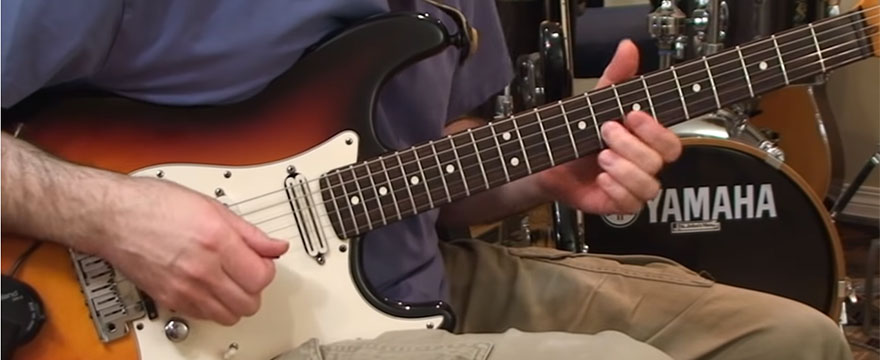What are the “Secrets” to accurately hearing recorded music and then figuring it out and performing it on our guitar? This lesson covers the elements involved with having success when it comes to performing any piece of music that we’re exposed to…
Q: I’m having a lot of trouble hearing guitar parts. Basically, if I don’t use the guitar TAB, I can’t learn songs. I get too frustrated trying to use my ear to learn guitar parts. Is there a secret I’m not aware of when it comes to learning songs by ear? Right now, this is really frustrating and I need a way to learn how to learn my songs by ear. Any suggestions?
Hernando – Los Angeles, California USA
A: Without having the ear training skill-set fully developed (for hearing roots, intervals and pitch), learning songs by ear is a task that would most certainly frustrate any guitarist.
These days, with the ease of access at which a guitarist can quickly visit any number of guitar websites and download a TAB, it is getting more common to find guitar players with a lot of weakness when it comes to learning music strictly by ear.
In this lesson, I will cover popular way that should be addressed when it comes to lifting songs off of albums using nothing but your guitar and your ears.
The lesson will also cover an approach for listening and hearing melodic ideas directly upon your guitar fingerboard.
Plus, we’re going to discuss audio editors. In this day and age it is important to have a highly functional piece of audio software. Good audio software should be at the ‘top of the list’ of tools that you use to be able to control how you hear song parts that you are transcribing.
AUDIO EDITING (DAW) SOFTWARE:
By using digital audio workstation (DAW) software, we can make the transcription process of a guitar part that we’d like to learn much easier to do, as well as, make the whole transcription procedure happen a lot faster.
Audio software can take the audio track and do tasks like; slow it down, or change the pitch of a file to more accurately match our instrument tuning.
This is time saving, since it is quite common where many studio recordings are slightly out of tune and we can use the software to fix that in a quarter of the time that it would take us to physically re-tune our guitar.
One of the longest standing and most popular pieces of software for audio transcription is, “Transcribe,” by Seventh-String software.
Transcribe has been a leader in the audio transcription field for over a decade. While there are many well known audio software packages that can be used to slow down audio, (including several Apple and Android apps), Transcribe by Seventh-String is certainly one of the best.
NOTE DISTANCE EXERCISES:
Learning about note distance is one of the first ways that a musician trains their ear. The process of learning how to recognize note distance involves repeatedly testing your knowledge for how to hear and then associate changes in music.
Think of a sound distance change as something which occurs when the gap between two notes is either increased or decreased across its span. This is referred to as musical “interval” training and it is important to develop this skill using exercises in relative pitch recognition and association.
In section two of the handout, (see example one), I have provided several intervals for you to try. Watch the video and study the handout by playing and listening to each example until every interval begins feeling more comfortable to your ear.
In example two, chord qualities are examined. The structure of applying major, minor and dominant chord tone qualities are outlined. These sounds are very important for when it comes down to hearing the specific effects of the different chord types.
MELODIC CONCEPTS:
Once single-note recognition comes together for a guitarist, the next step is learning to recognize and associate short melodic lines.
In example three, the concept of listening to “Linear Note Movement,” is covered using basic linear melody lines restricted to the 5th and 4th guitar strings.
Study the exercises provided in the handout (see example three), and in the video. Pay attention to the way the chord changes and the linear melody lines interact to produce the complete line of music.
Another important area of study is “intervallic movement.” This occurs when a melody jumps across wider interval space to form larger distances from one note to another.
In the handout on, page (3) example number four, the gap between the intervals of the melody have been increased.
Listen closely to the melodic flow of how the note distance has slightly increased as compared to the more linear melody found within example three.
NOTE: Once you are able to recognize the differences and you are able to associate the changes between these melodic ideas, hearing them will start to become much easier for you.
CONCLUSION:
Watch the video and download the PDF handout. Each of the examples that I have discussed here can be found within the handout. A song is also provided for you to learn as well.
The song included with this lesson (Stand Up), demonstrates a collection of both linear and intervallic melody examples. Learn the piece using the TAB chart along with the MP3 play along audio file that is provided within the lesson download.
- Click the button below to download the lesson handout
(access to lesson material will require a FREE membership)
